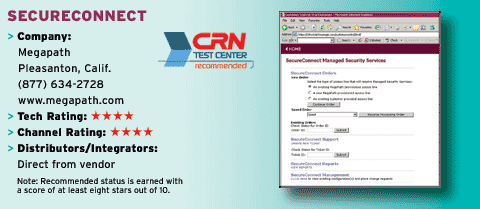The Future of Wireless?
Solution providers servicing the SMB space may want to take a look at a new wireless standard, referred to as MIMO (Multiple Input Multiple Output) technology. It is designed to increase both wireless bandwidth and range by taking advantage of multiplexing usage algorithms to transmit and receive over multiple antennas. And two companies delving into the MIMO market are Asus and Airgo.
Airgo is a pioneer in enhancing wireless technology and recently partnered with Asus to bring a true MIMO solution to the SMB space. Asus manufactures a wireless router and a PC card NIC that leverages the technology developed by Airgo.
The Asus router, Model WL566gM, will run integrators $129 and the PCMCIA notebook card, Model WL106gM, will cost $95. The two new Asus products are powered by Airgo's True MIMO Gen 3 wireless chipset. Airgo's new chipset now provides faster connection speeds than 10/100 Ethernet while remaining 100 percent compatible with 802.11b, 11g and 11a Wi-Fi.
The company claims that MIMO technology offers data rates up to 24 0Mbps, which is kind of a stretch. However, in the CRN Lab environment; the MIMO solution surpassed the performance of wired 100BaseT Ethernet. CRN engineers were able to maintain a wireless connection throughout every floor of a four-story dwelling. Obviously, the signal strength was weaker than it was when on the same floor as the router, but the difference was negligible.
It is important to note that the enormous performance gains were only accomplished with the Asus/Airgo proprietary hardware-software bundle and were not seen mixing and matching 802.11x standards with MIMO technology.
Installation consisted of connecting the router to the modem and running the setup wizard. Once the notebook client established a connection to the router using the 802.11g standard, the wireless connection on the client was disabled and a new connection was created using the Asus notebook card.
Once the software was installed, the client required a reboot. Upon startup, the Asus wireless router and card synced without any problems. The signal strength and the bandwidth utilization the client was receiving through the MIMO client-router connection was impressive.
The new MIMO technology is touted as providing faster-than-wired speeds on wireless systems. CRN engineers decided to put that technology to the test by downloading a printer driver of 73 Mbytes from HP's Web site on both a wired connection and then using the Asus MIMO connection. Both were connected through the same cable modem and no changes were made to either environment.
The wireless connection was able to download the file in less time than the 10/100 wired connection, which helps to promote MIMO as the future for wireless.
The new MIMO standard will eventually become the foundation for 802.11n. The next-generation technology will combine multiple antennas and double spectrum architecture to achieve raw data rates up to 600 Mbps.
Asus offers partners a three-tier channel program with no initial requirements to join, other than buying the product through an authorized distributor. Most partner interaction takes place through one of the 11 authorized distributors, which offer first-level support and credit opportunities. Asus will provide co-op opportunities for e-tailers and resellers pursuing television or print advertising for Asus products.
Asus is known to offer rebates and spifs to both resellers and distributors. What's more, Asus assists partners with training, product allocation and sales related needs.
Major resellers that meet specific revenue requirements are qualified for the AVP program, where Asus provides extra marketing support and AVP funds. A partner-specific portal provides sales, marketing and technical information and keeps partners abreast of the latest technical developments. While Asus leverages distributors to support VARs, the company seems well aware of the typical VAR needs and makes sure its distributors offer adequate support and opportunities.
